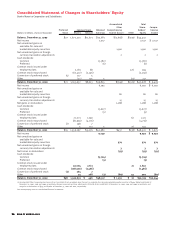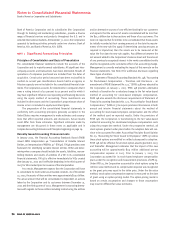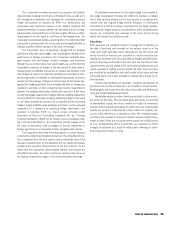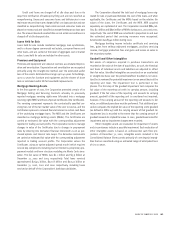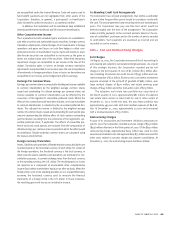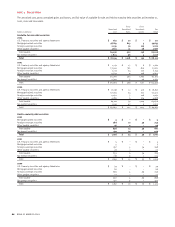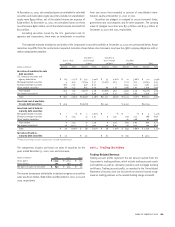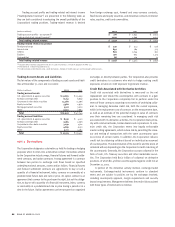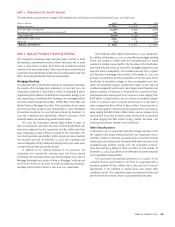Bank of America 2002 Annual Report Download - page 83
Download and view the complete annual report
Please find page 83 of the 2002 Bank of America annual report below. You can navigate through the pages in the report by either clicking on the pages listed below, or by using the keyword search tool below to find specific information within the annual report.
BANK OF AMERICA 2002 81
Credit card loans are charged off at 180 days past due or 60
days from notification of bankruptcy filing and are not classified as
nonperforming. Unsecured consumer loans and deficiencies in non
real estate secured loans are charged off at 120 days past due and
not
classified as nonperforming. Real estate secured consumer loans are
placed on nonaccrual and classified as nonperforming at 90 days past
due. The amount deemed uncollectible on real estate secured loans is
charged off at 180 days past due.
Loans Held for Sale
Loans held for sale include residential mortgage, loan syndications,
and to a lesser degree commercial real estate, consumer finance and
other loans, and are carried at the lower of aggregate cost or market
value. Loans held for sale are included in other assets.
Premises and Equipment
Premises and equipment are stated at cost less accumulated depreci-
ation and amortization. Depreciation and amortization are recognized
primarily using the straight-line method over the estimated useful
lives of the assets. Estimated lives range up to 40 years for buildings,
up to 12 years for furniture and equipment and the shorter of lease
term or estimated useful life for leasehold improvements.
Mortgage Banking Assets
In the first quarter of 2001, the Corporation amended certain of its
Mortgage Selling and Servicing Contracts whereby its previously
reported mortgage servicing rights were bifurcated into a mortgage
servicing right (MSR) and Excess Spread Certificates (the Certificates).
The servicing component represents the contractually specified ser-
vicing fees net of the fair market value of the cost to service, and the
Certificates represent a retained financial interest in certain cash flows
of the underlying mortgage loans. The MSR and the Certificates are
classified as mortgage banking assets (MBAs). The Certificates are
carried at estimated fair value with the corresponding adjustment
reported in trading account profits. The Corporation seeks to manage
changes in value of the Certificates due to changes in prepayment
rates by entering into derivative financial instruments such as pur-
chased options and interest rate swaps. The derivative instruments
are carried at estimated fair value with the corresponding adjustment
reported in trading account profits. The Corporation values the
Certificates using an option-adjusted spread model which requires
several key components including, but not limited to, proprietary pre-
payment models and term structure modeling via Monte Carlo simu-
lation. The fair value of MBAs was $2.1 billion and $3.9 billion at
December 31, 2002 and 2001, respectively. Total loans serviced
approximated $264.5 billion, $320.8 billion and $335.9 billion at
December 31, 2002, 2001 and 2000 respectively, including loans
serviced on behalf of the Corporation’s banking subsidiaries.
The Corporation allocated the total cost of mortgage loans orig-
inated for sale or purchased between the cost of the loans, and when
applicable, the Certificates and the MSRs based on the relative fair
values of the loans, the Certificates and the MSR. MSR acquired
separately are capitalized at cost. The Corporation recorded $884 mil-
lion, $1.1 billion and $836 million of MBAs during 2002, 2001 and 2000,
respectively. The cost of MSR was amortized in proportion to and over
the estimated period that servicing revenues were recognized.
Amortization was $540 million during 2000.
Mortgage banking income includes certificate and servicing
fees, gains from selling originated mortgages, ancillary servicing
income, mortgage production fees and gains and losses on sales to
the secondary market.
Goodwill and Other Intangibles
Net assets of companies acquired in purchase transactions are
recorded at fair value at the date of acquisition, as such, the historical
cost basis of individual assets and liabilities are adjusted to reflect
their fair value. Identified intangibles are amortized on an accelerated
or straight-line basis over the period benefited. Goodwill is not amor-
tized but is reviewed for potential impairment on an annual basis at the
reporting unit level. The impairment test is performed in two
phases. The first step of the goodwill impairment test compares the
fair value of the reporting unit with its carrying amount, including
goodwill. If the fair value of the reporting unit exceeds its carrying
amount, goodwill of the reporting unit is considered not impaired;
however, if the carrying amount of the reporting unit exceeds its fair
value, an additional procedure must be performed. That additional pro-
cedure compares the implied fair value of the reporting unit’s goodwill
(as defined in SFAS 142) with the carrying amount of that goodwill. An
impairment loss is recorded to the extent that the carrying amount of
goodwill exceeds its implied fair value. In 2002, goodwill was tested for
impairment and no impairment charges were recorded.
Other intangible assets are evaluated for impairment if events
and circumstances indicate a possible impairment. Such evaluation of
other intangible assets is based on undiscounted cash flow pro-
jections. At December 31, 2002, intangible assets included in the
Consolidated Balance Sheet consist primarily of core deposit intangi-
bles that are amortized using an estimated range of anticipated lives
of 6 to 20 years.





